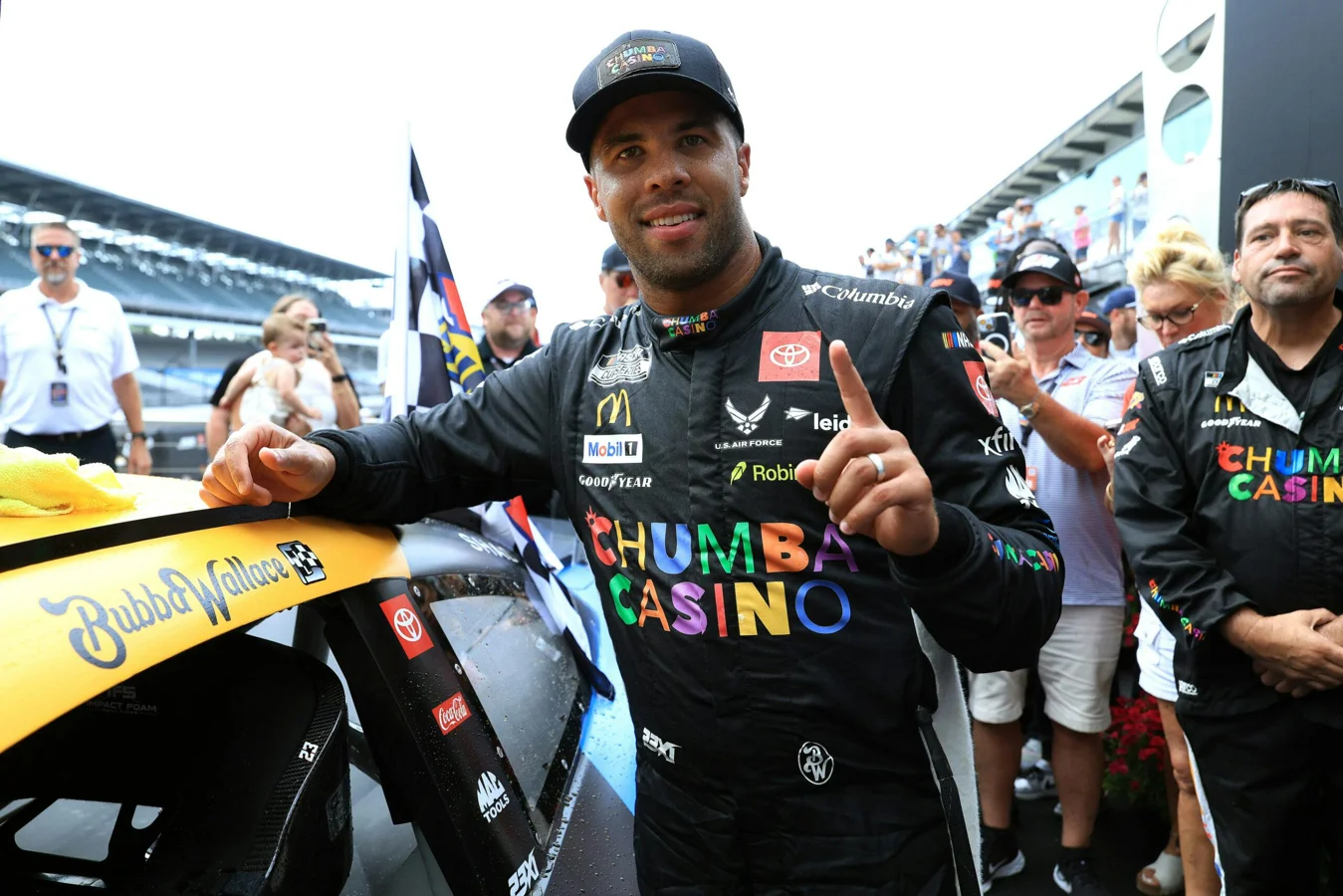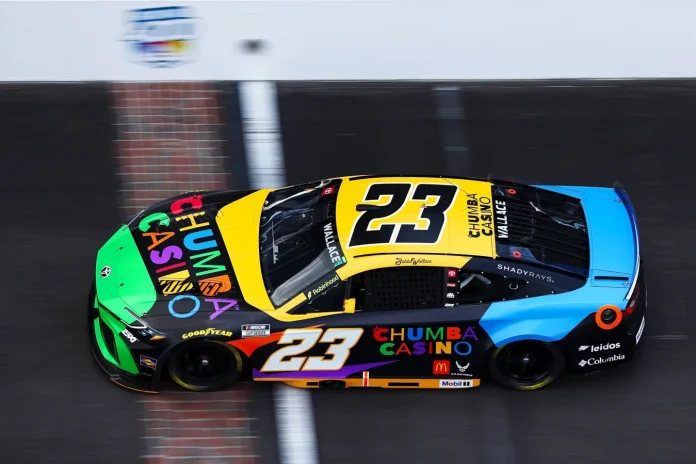The Bubba Wallace NASCAR controversy 2020 remains one of the most divisive events in recent motorsport history, with the incident at Talladega Superspeedway inciting waves of animosity based on a misunderstanding. Wallace’s career has since been overshadowed by hostility rooted not in his actions, but in a narrative that spiraled out of control, leaving a damaging impact on the NASCAR community and Wallace himself.
Polarization Surrounding Bubba Wallace’s NASCAR Journey
Bubba Wallace has become a flashpoint figure among NASCAR Cup Series fans, evoking strong reactions whenever his name is mentioned. During his tenure at 23XI Racing—a team established by Denny Hamlin and basketball legend Michael Jordan—Wallace was chosen as their primary driver, transitioning from Richard Petty Motorsports to become the public face of this new venture.
Even before joining 23XI Racing, Wallace had already become a favorite target for vitriolic commentary among NASCAR followers. Detractors seized on any perceived opportunity to diminish his presence in the sport, often reducing his success to factors beyond his driving ability.
As Michael Jordan openly asserted,
we don’t sign checks for losers
—Michael Jordan, Co-owner 23XI Racing, his defense of Wallace only intensified the divisive atmosphere around the No. 23 Toyota entry. The hostility Wallace continues to face can be directly tied back to one event in June 2020, a moment that fundamentally altered how he was viewed inside and outside the sport.

The Incident at Talladega and the Birth of a False Narrative
June 21, 2020, during a rain-postponed race weekend at Talladega Superspeedway, marked the genesis of the controversy. NASCAR released a statement revealing that a rope tied as a noose had been discovered in the garage space allocated to Wallace’s team. Declaring their outrage, NASCAR vowed to launch an immediate investigation and pressed the seriousness of the situation.
The nature and tone of NASCAR’s announcement left no room for ambiguity, sparking an immediate emotional response across the fanbase and media. Many believed a racist act had taken place. However, as days progressed and no additional evidence surfaced, doubts arose among some in the NASCAR community. Even with these suspicions, mainstream media voices and NASCAR itself consistently rejected any skepticism, labeling doubters as having no place in the sport.
The tone of the discourse was set: a crime was alleged, and any suggestion otherwise was met with condemnation. Under immense national scrutiny and within a climate already heavily influenced by broader societal tensions, the situation escalated rapidly.
FBI Investigation Debunks Crime Allegation
An investigation was promptly launched, with the FBI dispatching 15 agents to Talladega. Their findings revealed that the supposed noose was, in fact, a garage pull rope that had been installed as early as the previous October—long before Wallace had been assigned to that stall.
Fox Sports’ Bob Pockrass quickly provided photographic evidence from the previous year, displaying the very same pull rope in use while the garage space belonged to Paul Menard’s team. This revelation shifted the narrative: no hate crime had occurred. The initial statement from NASCAR, made in haste without thorough verification, proved to be a severe miscalculation that unnecessarily escalated the situation.
Despite the investigation’s outcome, many in the media and sections of the fanbase had already entrenched their opinions. The fallout led to vilification of anyone who questioned the prevailing narrative, and the incident became a case study in the dangers of hastily amplifying unverified claims. Critics accused NASCAR of exploiting the controversy for positive media attention, especially coming closely after the organization’s decision to ban the Confederate flag at events.
Look at how not racist we are again!
—Unattributed
This phrase encapsulated the widespread perception that NASCAR was more concerned with projecting an image of moral leadership than establishing facts.
The Consequences for Bubba Wallace
In the aftermath, it was Bubba Wallace who experienced the brunt of the backlash, his reputation unfairly tethered to the incident. Although Wallace appeared in media interviews to discuss the event, he was reacting to information provided directly by NASCAR. The original statement omitted vital qualifiers, such as alleged, presenting a definitive accusation rather than a developing investigation.
This led to heightened scrutiny and blame placed on Wallace, despite his limited direct involvement. He had not seen the rope in question, nor had he orchestrated the reaction. Wallace responded publicly according to the facts as they were relayed to him, yet his detractors sought to vilify him, claiming he benefited from the controversy or actively perpetuated it—claims unfounded by the later revelation of facts.
Wallace later conceded that the affair did not present well in retrospect. He recognized the optics were problematic, acknowledging that those initially skeptical had ultimately been justified. His willingness to express regret showed a level of realism and emotional honesty, characteristics long observed by fans and media alike.
Responses and Admission of Fault by NASCAR Leadership
The controversy did not just resonate with fans and media; it prompted reflection among NASCAR officials and veteran drivers. Jimmie Johnson later remarked that the simple inclusion of the word alleged in the press release would have markedly changed the public reaction, reducing the polarization.
NASCAR President Steve Phelps ultimately admitted that not qualifying their statement led to the mismanaged public fallout. This admission came after over a year of negative consequences for Wallace, who bore the lasting effects of an uproar rooted in flawed communication and procedural mistakes by NASCAR’s leadership.
The Lingering Impact on Bubba Wallace and NASCAR
The 2020 incident fundamentally altered the course of Bubba Wallace’s relationship with the broader NASCAR fanbase. The disjunction between the actual events and the mythology that developed in public discourse has remained stark. Even as facts disproved the initial hate crime story, much of the hostility toward Wallace persisted, detached from objective reality.
Wallace, who achieved victory at the Brickyard 400 and continued to compete at a high level, remains a lightning rod for sentiment within the sport. It is important to recognize that resentment targeting Wallace is not fueled by his actions, but by a series of institutional missteps and a media environment that escalated a misunderstanding into a divisive spectacle.
Believe in something, even if it didn’t happen
—Unattributed
This meme became emblematic of the situation, symbolizing how belief in a narrative can overshadow the facts, regardless of their eventual revelation.
A Path Forward for the NASCAR Community
More than five years after the Talladega incident, the NASCAR community still grapples with the fallout. The Bubba Wallace NASCAR controversy 2020 remains a cautionary tale about the risks of reactive communication, sensationalism, and the long-term damage inflicted on individuals caught in the crossfire.
Understanding the true sequence of events and the institutional failures involved is crucial to preventing similar outcomes in the future. For fans, a reconsideration of their perception of Bubba Wallace may be warranted, grounded in the facts established by independent investigation. As the sport moves forward, lessons from this controversy can serve to foster a fairer, more responsible environment for all participants and fans alike.


